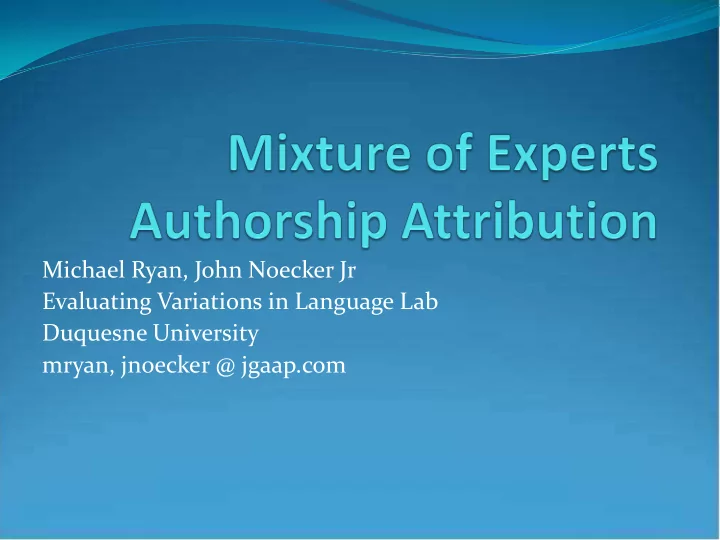

Michael Ryan, John Noecker Jr Evaluating Variations in Language Lab Duquesne University mryan, jnoecker @ jgaap.com
Tools JGAAP (Java Graphical Authorship Attribution Program) - a modular test bed for authorship attribution methods. All methods used are either available in JGAAP or were extensions of it Source code for the methods used in this experiment is available at jgaap.com
Mixture of Experts Combined three Authorship Attribution techniques Each technique assigns a vote on the author of the document If there is not majority author assume the author was not in the sample group
Centroid L1 Break documents into feature vectors of character 3- grams using relative frequencies of 3-grams Build Centroids for the known authors Take the average of that authors feature vectors Measure the L1 Distance between the authors’ centroids and the unknown’s feature vector Assign your vote to the author whose centroid had the smallest L1 Distance
WEKA SMO Break documents into feature vectors of character 3- grams using relative frequencies of 3-grams Train WEKA’s Sequential Minimal Optimization Support Vector Machines (SMO) using the known authors’ feature vectors SMO will rate authors similarity Assign a vote to the most similar author
Repeated Microdocument Analysis Break all documents into 3,000 character chunks Reduce all contiguous whitespace to single spaces and all character to lower case Break chunks into feature vectors of character 11-grams using relative frequencies of 11-grams Generate Centroids for the known authors Take the average of the author’s feature vectors Measure the Intersection Distance between the author centroids and chunks, assigning the closest centroid’s author to each chunk Vote on the author who receives a majority of the chunks
Author Diarization Method Break documents into paragraphs Extract named entities from paragraphs Group paragraphs with named entities in common Assume each group is an author Use the grouped paragraphs as known chunks with Repeated Microdocument Analysis and ungrouped paragraphs as unknowns Add the ungrouped paragraph that is closest to a group to that group and re-run the analysis until all paragraphs are grouped
Results Problem Number Correct Total Accuracy A 6 6 100% B 7 10 70% C 7 8 87.5% D 10 17 58.8% E 83 90 92.2% F 77 80 96.3% I 12 14 85.7% J 12 16 75.0% Total 214 241 88.8%
Conclusions These methods show promise with document accuracy of 88.8% and mean accuracy of 83.2%, respectively first and third in the competition. The method used preformed poorly on open-class problems because they were developed with only closed class in mind, removing the open-class portions changes our accuracies to 91.6% and 88.5%
Future Work Refine analysis of open-class problems by examining how different experts preform in identifying them and how many experts it takes to reach a conclusion.
Recommend
More recommend